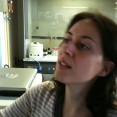Nannochloropsis gaditana growth and lipids
Acclimation of Nannochloropsis gaditana to different illumination regimes: effects on lipids accumulation.
Abstract
Algae are interesting potential sources of biodiesel, although research is still needed to develop efficient large scale productions. One major factor affecting productivity is light use efficiency. The effect of different light regimes on the seawater alga Nannochloropsis gaditana was accessed monitoring growth rate and photosynthetic performances. N. gaditana showed the capacity of acclimating to different light intensities, optimizing its photosynthetic apparatus to illumination. Thanks to this response, N. gaditana maintained similar growth rates under a wide range of irradiances, suggesting that this organism is a valuable candidate for outdoor productions in variable conditions. In the conditions tested here, without external CO(2) supply, light intensity alone was not found to be a major signal affecting lipids accumulation showing the absence of a direct regulatory link between the light stress and lipids accumulation. Strong illumination can nevertheless indirectly influences lipid accumulation if combined with other stresses or in the presence of excess CO(2).
Copyright © 2011 Elsevier Ltd. All rights reserved.
